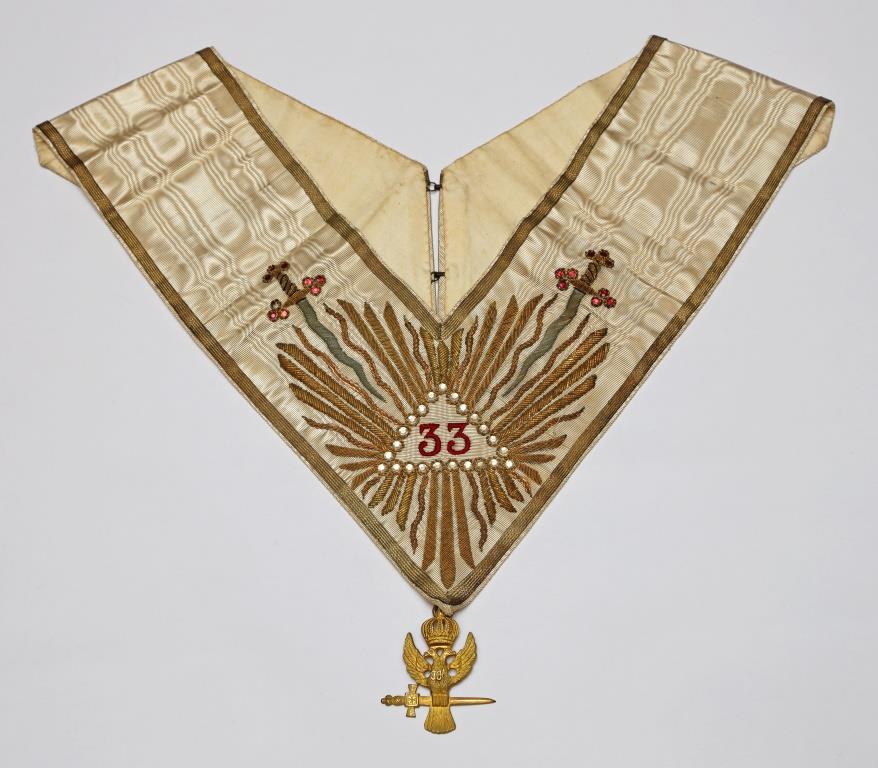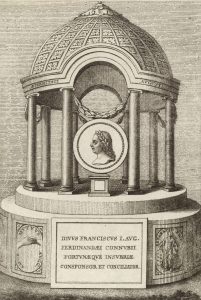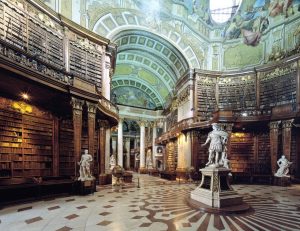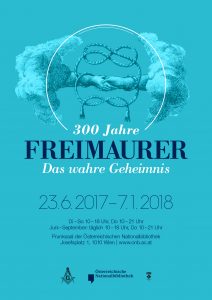300 Years of Freemasons – in the State Hall of the Austrian National Library

A special anniversary exhibition
Probably all of us have a bit of a penchant for mysticism and conspiracy theories, more or less. The Freemasons have always been secretive, and outsiders have had little to no insight into the world of the brotherhood that is so shrouded in secrecy. The exhibition “300 Years of Freemasons” in the State Hall of the Austrian National Library offers an opportunity, through January 7, 2018, to look a bit behind the scenes of the Freemasons.
The True Secret
The exhibition’s subtitle promises to solve a number of mysteries and disclose secrets. I should tell you straightaway that I didn’t get this impression personally; maybe my expectations were set too high due to the title.
In fact, the exhibition presents the history of modern Freemasonry as of the founding of the “Great Lodge of England” in the year 1717, its spreading throughout Europe and especially Austria, the organization’s core ideas and its external perception and impact during the various epochs until today.
More than 150 unique objects on exhibit from domestic and international collections underscore and illustrate the scope of the secretive group. Also most impressive is the list of prominent international and Austrian members, among them Franz Stephan von Lothringen and Joseph Haydn, Wolfgang Amadeus Mozart and George Washington, Carl Millöcker and Winston Churchill, Fritz Grünbaum and Marc Chagall, Josephine Baker and Charles Lindbergh, Fritz Muliar and many others from the beginnings of Austrian Freemasonry to the present day.
An excursion
Freemasonry is presented and explained at several stations, beginning with its virtues such as reliability, charity and fairness, to the guiding principles of the Enlightenment – freedom, equality, fraternity – all the way to its ethical values. Its emergence in England is further illuminated, as is its spreading throughout Europe and into Austria.
The 1780s witnessed its first blossoming in Austria, with members from the arts, culture, sciences and research. Mozart was thereby admitted to the brotherhood in 1784 – Haydn followed the enthusiastic Mozart. The opera The Magic Flute reflects the spirit of Freemasonry in several of its scenes.

Temple with medallion of Emperor Franz Stephan von Lothringen, copper engraving of Jac. Mercorus, 1780 © Österreichische Nationalbibliothek
Another station in the exhibition is dedicated to the activities of the lodges in secret after the outbreak of the French Revolution in 1789 and the ban on Freemasonry in 1795. The symbols, rituals and admission rites are of course also shown and explained, while another point involves the various ranks of the lodge brothers and their relationships to women – here, tradition and equal rights are contrasted starkly with one another.
The emergence of the Grenzlogen (border lodges) around 1848 and the pacifists before and during the First World War are topics in the exhibition, as is the great Aufbruch (interwar) era between the World Wars. Numerous representatives of “Red Vienna” were members of the brotherhood at the time and carried their ideas into society. The ensuing era of National Socialism was marked by hatred, prohibition and persecution for the Freemasons; Jewish members and opponents of the Nazi regime were especially affected.
In the post-war era, Freemasonry underwent another blossoming – as an antithesis, so to speak, to the society that continued to be marked by war, the Cold War and the strong Catholicism of the time. Artists, writers, journalists and actors in particular were admitted to the brotherhood, where they could meet one another independently of party ideologies and continue to develop themselves.
The special relationship of the Freemasons to the notion of the era and the brotherhood’s special commemorative culture form the conclusion to the exhibition.
My conclusion: A great, informative exhibition – with beautiful showpieces and impressive information – that is definitively worth a visit (the State Hall plays its role as well). The “true secret” is not disclosed – and maybe it’s better that way. The allure of the hidden and the unknown are thus preserved, and thereby the special interest in the Freemasons as well. Maybe the “secret” exists, based on the symbols and rituals that have been mystified over 300 years, only in our minds and imaginations…
Information:
300 Years of Freemasons
The True Secret
from June 23, 2017 – January 7, 2018
in the State Hall of the Austrian National Library
1010 Vienna, Josefsplatz 1
Homepage
Opening hours:
Tuesday – Sunday 10:00 AM – 6:00 PM, Thursdays until 9:00 PM
Open daily in August and September 2017.
Admission prices:
€ 7.00 per adult
Children and youth under 19 years of age – free admission.
Tours in German – every Thursday at 6:00 PM: surcharge of € 4.00 per person
Children’s tours in German at special times – see homepage.
A beautiful book to accompany the exhibition has also been published; it is available for purchase at the ticket office of the State Hall for € 29.90.
Data and image sources: © Austrian National Library – with gratitude for their kind assistance.












